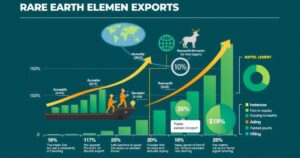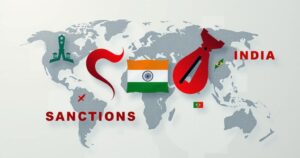Weekly News Roundup: Shifts in Semiconductor Landscape as China, Samsung, TSMC Make Moves

This week’s tech news reveals China’s advancements in lithography equipment, Samsung’s recovery in foundry orders, and TSMC’s expansion strategy, as Europe considers a ban on Chinese solar inverters. Key dynamics are shifting in the global semiconductor landscape amid strategic moves from these major players.
In the latest tech news from May 12 to May 18, significant shifts were observed across the semiconductor landscape. China is ramping up its domestic lithography capabilities. Samsung is seeing a resurgence in foundry orders, while Taiwan Semiconductor Manufacturing Company (TSMC) is aggressively expanding its global footprint. Additionally, Europe is contemplating a ban on Chinese solar inverters as cybersecurity concerns rise.
China’s lithography equipment development is progressing, especially in deep ultraviolet (DUV) technology. The country is unveiling a 193nm dry ArF system with a resolution of 65nm and an overlay accuracy of 8nm, although it remains behind the global standards. Research efforts in immersion DUV are spearheaded by the Chinese Academy of Sciences and others, with rumors about a 28nm immersion prototype from SMEE, but these developments are still unverified and not ready for production. These initiatives reflect China’s ongoing ambition for semiconductor self-sufficiency, despite advanced lithography processes being years away from maturity.
Samsung Electronics has clinched an important 8nm foundry order from Nintendo for the upcoming Switch 2, anticipated to ship 15 million units in fiscal 2025. This order utilizes an Nvidia Tegra System on Chip (SoC) which may lead to future contracts with Nvidia and Qualcomm, who are currently evaluating Samsung’s newer 2nm Gate-all-around (GAA) process. Samsung’s current yield rates for the 2nm process are about 40–50%, with aspirations to increase to 60% for full production. Furthermore, the company is restarting idle production lines, with a full-scale ramp-up expected by the latter half of 2025.
As Chinese integrated device manufacturers (IDMs) are gaining traction, Europe’s semiconductor giants seem to be faltering. The global power semiconductor market shrank to $32.3 billion in 2024, while Chinese firms Silan and BYD climbed into sixth and seventh place internationally with market shares of 3.3% and 3.1%, respectively. Silan reported $1.066 billion in revenue while BYD’s electric vehicle sales surged to 4.25 million units. Meanwhile, major European players like Infineon and STMicro-electronics experienced market share declines.
To bolster their national chip industry, China is aiming for a self-sufficiency rate of 25% by 2025. Silan is ramping up its Insulated Gate Bipolar Transistor (IGBT) and Silicon Carbide (SiC) production capabilities via projects in Chengdu and Xiamen. Hua Hong Semiconductor is also expanding, enhancing its foundry potential while partnering with STMicro.
Meanwhile, TSMC is planning to accelerate its expansion through the establishment of eight new wafer fabs and one advanced packaging facility by 2025 to cater to increasing AI and high-performance computing demands. Production in its 2nm fabs located in Hsinchu and Kaohsiung will commence this year, while Fab 25 in Taichung is slated for completion by 2028. AI chip shipments are projected to skyrocket, with expected growth of 12 times from 2021 to 2025. MediaTek is also gearing up to meet emerging trends in low-latency machine learning, edge computing, and 6G technology slowly replacing older generations of silicon.
In a notable partnership, MediaTek and Nvidia are poised to launch a joint AI PC platform in 2025 featuring Nvidia’s GB10 Grace Blackwell chip as part of their ambitious $3,000 Project Digits. This collaboration seeks to penetrate sectors like edge-focused AI and smart vehicles, with key support from major brands such as Dell and HP. However, the ongoing talent drain to Nvidia raises significant concerns for MediaTek’s stability and operational strength.
In another move confirming its influence, TSMC approved the sale of equipment worth $71-73 million to VisionPower Semiconductor Manufacturing Company (VSMC), a joint venture designed to boost production capabilities in Singapore. VSMC’s fab is on track for mass production by 2027, with an initial output expected by late 2026. For reference, TSMC’s first-quarter 2025 revenue hit NT$839.25 billion (about $25.53 billion), with a net income of NT$361.56 billion.
Furthermore, Europe is contemplating a ban on Chinese solar inverters, primarily from firms like Huawei and Sungrow due to cybersecurity threats. The EU derives approximately 80% of its inverters from China, and the prospect of potential disruptions has raised serious alarms. The European Solar Manufacturing Council has proposed an “Inverter Security Toolbox,” while Huawei finds itself at risk of exclusion from significant EU industry groups. Critics are warning that such a ban might bolster costs by up to 50%, yet the EU Commission is assessing the broader risks to grid integrity.
This week saw pivotal developments in the tech industry. China is step up its lithography equipment capabilities amidst geopolitical tensions. Samsung is revitalizing its foundry sector with key orders, while TSMC is aggressively expanding its production capabilities to meet surging demand. Overall, shifts are evident, particularly as Europe weighs significant policy changes regarding Chinese tech imports.
Original Source: www.digitimes.com






